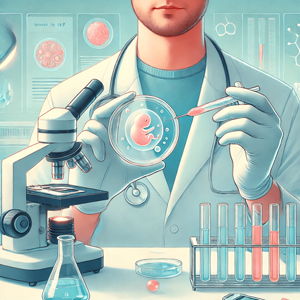What Is IVF and How Does It Work?

In vitro fertilisation (IVF) is a widely used fertility treatment that has made parenthood possible for millions. If you are new to your fertility treatment or thinking about options, it is critical that you know how IVF works so you can best decide. Let us walk through the IVF step by step, discuss success rates, and touch upon costs.
Step-by-Step IVF Process
IVF is a multi-step procedure involving close medical monitoring, precision timing, and individually customised therapy. Below are stages you can anticipate in a standard IVF cycle:
- Ovarian Stimulation: A woman releases one egg each month. In IVF, a woman is given fertility drugs to get multiple eggs out at once to improve chances for successful conception.
- Medications: Injections of hormones are given for 10–14 days to induce the formation of eggs. Routine blood tests and ultrasounds follow upon progress.
- Egg collection: The egg is collected once mature after a relatively minor surgical procedure called follicular aspiration, conducted under sedation or anaesthesia for pain.
- Fertilisation: The sperm are combined with eggs in a lab. Fertilisation can be natural or by intracytoplasmic sperm injection (ICSI), where ones perm is injected into one egg.
- Embryo culture: The eggs are incubated for a time frame ranging from 3-5 days before they are made ready for transfer into a woman’s uterus.
- Embryo Transfer: The chosen embryo is deposited in the woman’s uterus by a painless but straightforward procedure, akin to a cervical smear.
- Pregnancy Test: After a span of about 10–14 days, a blood test confirms whether the procedure was successful in resulting in a pregnancy.
IVF Success Rate by Age
IVF success varies considerably by age, among other variables. According to the HFEA and SART, here are some average rates by age
- Female age less than 35 years: Approximately 32-50% chance per IVF cycle.
- Women between 35-37: About 30-40%.
- Women aged 38-40 years: About 20-27%.
40+ women: Success rates fall to 5-12%, although use of donated eggs can greatly improve success CDC International Fertility Group
It is also significant to note that additional variables including overall fertility status, lifestyle, and embryo transfer quantity can also influence. Age remains the most crucial variable in using one’s own eggs for IVF, however.
What to Expect from IVF Treatment
The IVF cycle can be emotionally taxing as well as physically challenging. Aside from medical procedures, you may also need to contend with side effects from fertility drugs, ranging from bloating and mood swingsto discomfort after retrieving your eggs. You’ll need a solid support network—whether family, friends, or a fertility counselor.
An IVF cycle typically lasts between 4 to 6 weeks, although this can be variable. You might require more than one cycle in your case,depending upon your response.
How Much Does IVF Cost?
IVF can cost a lot. One cycle of IVF in the UK can cost between £5,000 to £8,000, depending upon your choice of clinic, plus any other procedures. Fertility drugs will add a further £1,000 to £2,500. Genetic screening, frozen embryo transfer, or using donated eggs means extra expenses. Many explore options such as insurance cover (where available), loans, and employer-sponsored benefits covering fertility treatment. Some areeven able to have NHS-funded IVF cycles if they meet criteria. Forexploring options, see our IVF funding and financial advice.
Conclusion
IVF has transformed the treatment of fertility, bringing hope to so many individuals who cannot conceive. Though the treatment maybe complicated and costly, it provides a certain pathway to parenthood. The success rate has been enhanced with improvements in reproductive technology, and IVF is rapidly becoming an increasingly realistic option for individuals.
If you are considering IVF, a consultation with a fertility specialist can be essential to discuss your choices and create a suitable treatment plan for you. With the right fertility clinic and support group, IVF can be your key to fulfilling your family dreams.
Ready to start your IVF journey? Choose a highly-rated fertility clinic from our rankings, or schedule a consultation with a specialist today.
FAQ Section:
What is the average success rate for IVF?
On average, about one-third of IVF cycles are successful. This cumulative rate varies with age, at 32-50% in women younger than age 35, and at 5-12% in women over age 40. Donor eggs can improve rates despite a woman’s increasing age.
Is IVF painful?
IVF hurts to a certain extent, mainly egg retrieval. Pain medication is given, however, and most people are able to tolerate it.
How many cycles of IVF are usually needed?
No more than eight cycles are usually recommended. Cycles aredifferent; while one may conceive with one cycle, another may need more than one cycle. You would be best served by speaking with a fertility specialist about your case.
Further Reading:
- Learn more about IVF Success Rates by Age from the HFEA.
- Explore the IVF Process Explained on the NHS website.
Discover more about IVF Costs and Financial Options in our detailed financial guide.


 Previous
Previous

